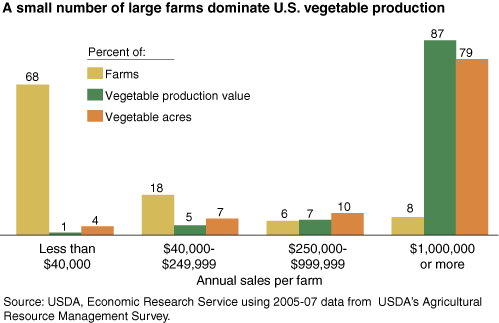Vegetable Production Concentrated on Very Large Farms
- by Mir Ali and Gary Lucier
- 6/16/2011
Very large commercial farms (with $1 million or more of agricultural sales per year) accounted for about 8 percent of all U.S. specialized vegetable and melon farms during 2005-07. Specialized farms, which derive at least 50 percent of their revenue from vegetable and melon sales, accounted for 87 percent of U.S. vegetable crop value in 2005-07.
In terms of financial characteristics among specialized vegetable and melon operations, very large farms stand apart from other farm classes. Net farm income per farm during 2005-07 was at least 10 times that of any other specialized vegetable-farm size class, while average farm equity was more than 3 times as great. With rising real estate values, average equity on these very large farms jumped 40 percent between 1999-2001 and 2005-07. The strong equity position of very large farms reflected an asset base exceeding $6 million per farm, the result of an extensive complement of farm machinery and an average of 2,000 highly valued acres of farmland.
With greater average sales per acre than most field crops, fresh-market vegetables like potatoes, tomatoes, peppers, and asparagus tend to be concentrated on farms with annual sales exceeding $1 million. Although these farms tend to be physically large and grow a variety of crops, some of the fresh-market vegetable enterprises do not require many acres to generate substantial revenue. For example, during 2007-09, the average per acre farm value of U.S. fresh-market field tomato production was $12,238, meaning that a farm with just 82 acres of fresh tomatoes could have farm sales in excess of $1 million. In contrast, about 1,500 acres of sweet corn for processing would be required to reach $1 million in sales.
Vegetable and melon production has shifted toward large operations for several reasons, both physical and economic. While physical influences largely center on climate and soils, economic considerations include improvements in long-distance transportation, ability to supply price-conscious national wholesalers and retailers year round, and low-cost competition from other countries. The efficiencies afforded by large specialized vegetable and melon farms has helped limit import penetration, kept average vegetable prices more affordable, and preserved the economic viability of the domestic industry.
The finding is based on data from USDA's annual Agricultural Resource Management Survey, the primary source of information on the financial conditions, production practices, resource use, and economic well-being of America's farm households.
This article is drawn from:
- Ali, M. & Lucier, G. (2011). Vegetables and Melons Outlook: February 2011. U.S. Department of Agriculture, Economic Research Service. VGS-342-01.
You may also like:
- ARMS Farm Financial and Crop Production Practices. (n.d.). U.S. Department of Agriculture, Economic Research Service.
- Vegetables and Pulses. (n.d.). U.S. Department of Agriculture, Economic Research Service.
We’d welcome your feedback!
Would you be willing to answer a few quick questions about your experience?


